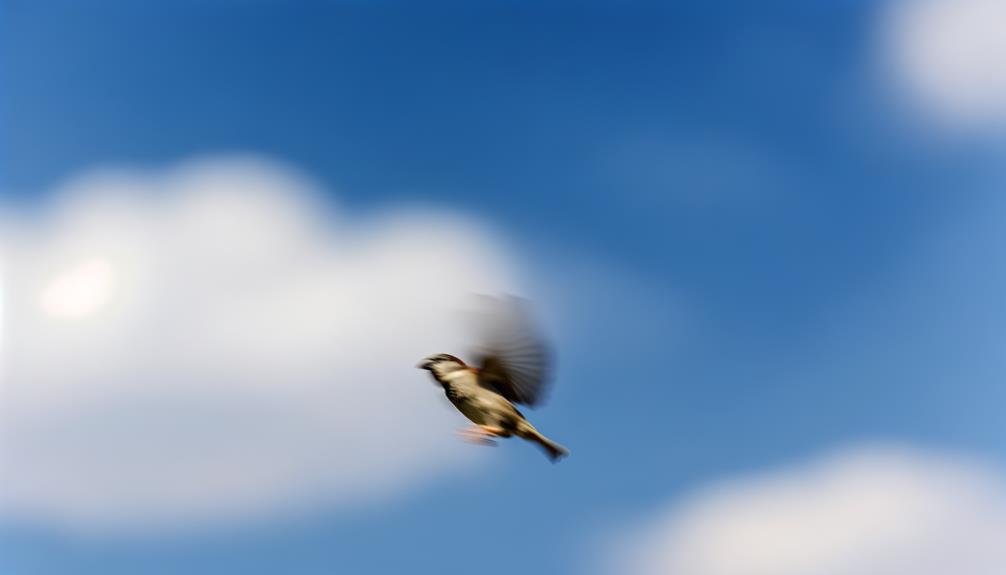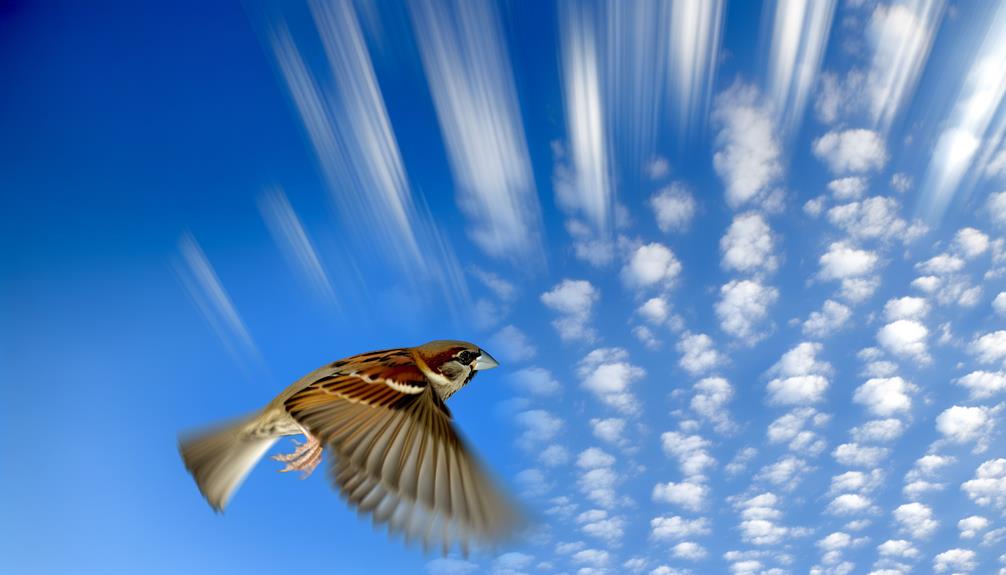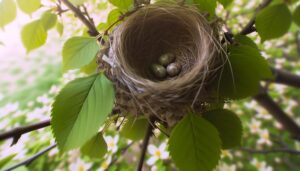How Many Times Does a Sparrow Flap Its Wings: A Step-by-Step Guide
Sparrows typically flap their wings at a frequency of 15 to 20 beats per second. This rate can vary slightly, with juvenile sparrows usually exhibiting higher frequencies due to their developing flight muscles.
The wing beat frequency is influenced by both intrinsic factors, such as muscle power and wing structure, and extrinsic factors, including wind conditions and air density. Foraging tactics and predator evasion also play a role in altering their wing beat frequency.
Understanding these dynamics provides deeper insights into avian biomechanics and energy expenditure during flight. Exploring further will reveal how these factors impact migratory behaviors and ecological adaptations.

Key Takeaways
- Sparrows flap their wings at a frequency of 15-20 beats per second.
- Juvenile sparrows tend to have higher wing beat frequencies than adults.
- Wing beat frequency varies due to factors like metabolic rates and flight strategies.
- External conditions such as wind and air density can influence the wing beat frequency.
- Sparrows need rapid wingbeats for agile maneuvers and quick directional changes.
Sparrow Wing Beat Frequency

The wing beat frequency of sparrows typically ranges between 15 to 20 beats per second, depending on various factors such as species, age, and environmental conditions. This rapid oscillation is pivotal for maintaining flight stability and maneuverability.
Detailed observations indicate that juveniles generally exhibit a higher frequency compared to adults, likely due to their smaller wing span and muscle development. Additionally, variations in wing beat frequency can be attributed to metabolic rates and flight strategies employed during different activities, such as foraging or evading predators.
The aerodynamic properties of sparrows' wings, characterized by their elliptical shape, further facilitate efficient and rapid wing movements. Understanding these nuances provides valuable insights into the biomechanics and ecological adaptations of these avian species.
Factors Influencing Wing Flaps
Several intrinsic and extrinsic factors significantly impact the frequency and mechanics of sparrow wing flaps. Intrinsic factors include muscle power and wing structure, while extrinsic elements encompass environmental variables like wind conditions and air density. Moreover, behavioral aspects such as foraging tactics and predator evasion influence wing flap frequency. The interplay of these factors results in a dynamic range of wing beat frequencies observed in sparrows under varying conditions.
| Factor Type | Specific Factor | Effect on Wing Flaps |
|---|---|---|
| Intrinsic | Muscle Power | Higher power, fewer flaps |
| Intrinsic | Wing Structure | Ideal shape, efficient flaps |
| Extrinsic | Wind Conditions | Strong wind, modified flaps |
| Extrinsic | Air Density | Lesser density, faster flaps |
| Behavioral | Foraging Tactics | Efficient foraging, fewer flaps |
Understanding these factors enhances our comprehension of the physiological and environmental influences on sparrow flight mechanics.
Energy Expenditure in Flight

Understanding the energy expenditure in a sparrow's flight necessitates examining the metabolic cost analysis, which quantifies the energy utilized during wing flapping.
Additionally, evaluating flight muscle efficiency provides insights into how effectively muscle contractions convert metabolic energy to mechanical work.
Lastly, the relationship between caloric intake and energy expenditure reveals how dietary consumption supports the high energy demands of sustained flight.
Metabolic Cost Analysis
Frequently, the metabolic cost of a sparrow's wing flapping is measured by evaluating its oxygen consumption and caloric expenditure during sustained flight. Through respirometry, researchers can precisely quantify the oxygen uptake, which directly correlates with energy expended.
Sparrows exhibit high metabolic rates due to the rapid, continuous motion required for flight. Studies indicate that the average energy expenditure during flight ranges from 8 to 14 kcal per hour, depending on flight speed and environmental conditions. The metabolic rate is influenced by factors such as air density, temperature, and altitude.
Additionally, the energy cost is modulated by the aerodynamic efficiency of the wingbeat pattern, which affects overall endurance and flight duration. Such detailed metabolic analysis is fundamental for understanding avian energetics.
Flight Muscle Efficiency
In examining the metabolic cost of a sparrow's flight, it is essential to assess the efficiency of its flight muscles, which directly impacts the bird's overall energy expenditure.
Flight muscles, mainly the pectoralis and supracoracoideus, are highly adapted for sustained activity and rapid contractions. These muscles show a high mitochondrial density, facilitating efficient ATP production through oxidative phosphorylation.
Additionally, the flight muscle fibers are mainly of the fast-twitch type, allowing for rapid and forceful wing flaps. The sparrow's energy expenditure is further minimized by an ideal wing loading and aspect ratio, enhancing aerodynamic efficiency.
Consequently, understanding these physiological and biomechanical adaptations provides insights into the sparrow's remarkable flight endurance and energy management strategies.
Caloric Intake Correlation
A sparrow's caloric intake is intricately correlated with its energy expenditure during flight, necessitating a precise balance between nutrient consumption and the metabolic demands of sustained wing activity. Research indicates that sparrows consume approximately 10-15 kilocalories per day, with a significant portion allocated to flight.
During high-intensity flight, metabolic rates can increase up to 15 times the basal metabolic rate. This elevated energy demand requires efficient utilization of carbohydrates and lipids. Inadequate caloric intake can lead to muscle fatigue and impaired flight performance.
Conversely, excess calorie consumption can result in unwanted weight gain, further increasing the energy required for flight. Hence, the relationship between caloric intake and energy expenditure is crucial for maintaining the best flight efficiency and overall avian health.
Comparison to Other Birds
When comparing the wing flap rates of sparrows to other birds, significant differences emerge.
For instance, a hummingbird can achieve an astonishing 50–80 flaps per second, far surpassing the sparrow's approximate rate of 15–20 flaps per second.
In contrast, larger birds such as eagles exhibit much lower flap rates, averaging around 1-2 flaps per second, highlighting the aerodynamic and physiological adaptations across avian species.
Sparrow Vs. Hummingbird Flaps
Comparing the wing flaps of sparrows and hummingbirds reveals significant differences in frequency, biomechanics, and energy expenditure.
Hummingbirds exhibit an extraordinary wingbeat frequency, flapping their wings approximately 50-80 times per second. This rapid motion is facilitated by a unique ball-and-socket joint at the shoulder, allowing a full 180-degree arc.
In contrast, sparrows typically flap their wings around 15-20 times per second. This lower frequency is supported by a more conventional wing structure optimized for short bursts of flight and quick directional changes.
The energy expenditure for hummingbirds is substantially higher, requiring nearly continuous feeding on nectar to sustain their rapid metabolism. Sparrows, having a slower wingbeat, have a comparatively lower metabolic rate and energy requirement.
Flap Rates: Sparrow Vs. Eagle
In analyzing wing flap rates among birds, sparrows exhibit a wingbeat frequency of 15-20 times per second, whereas eagles demonstrate a much lower rate of approximately 1-2 flaps per second. This stark contrast illustrates the adaptations of these avian species to their respective ecological niches.
Sparrows, being small and agile, require rapid wingbeats for maneuverability and sustained flight. Conversely, eagles, with their massive wingspans, utilize soaring and gliding to conserve energy.
Key observations include:
- Wingbeat Frequency: Sparrows: 15-20 flaps/sec; Eagles: 1-2 flaps/sec.
- Energy Expenditure: Higher in sparrows due to continuous flapping; lower in eagles due to soaring.
- Flight Mechanics: Sparrows rely on rapid, frequent wingbeats; eagles leverage thermal currents and gliding.
Understanding these differences underscores the evolutionary adaptations in avian flight mechanics.
Impact on Migration Patterns

The frequency of wing flapping in sparrows greatly influences their energy expenditure and, consequently, their migration patterns. High flap rates increase metabolic demands, requiring frequent stops for foraging and rest during long migratory journeys.
This energy-intensive flight mode limits the distance sparrows can travel without breaks, thereby impacting their migratory routes and timing. In contrast, species with lower flap rates can sustain longer flights, optimizing their migration efficiency.
Detailed observations reveal that sparrows adjust their flap rates based on environmental factors such as wind currents and availability of food sources. This adaptive behavior guarantees energy conservation and enhances survival during migration, underscoring the critical role of wing flapping frequency in shaping migratory strategies.
Observing Sparrow Flight Mechanics
Detailed examination of sparrow flight mechanics reveals intricate patterns in wing movement and body posture, necessary for understanding their aerodynamic efficiency and energy expenditure. High-speed video analysis and biomechanical studies have identified several key aspects of their flight behavior:
- Wingbeat Frequency: Sparrows typically flap their wings at a rate of 15-18 beats per second, varying with flight speed and maneuvering needs.
- Stroke Plane Orientation: The angle at which sparrows flap their wings changes dynamically to optimize lift and thrust during various phases of flight.
- Body Position Adjustments: Sparrows exhibit precise control over their body posture, adjusting their tail and head positions to maintain balance and direction.
These observations underscore the complexity and adaptability of sparrow flight, essential for both short bursts and prolonged flights.
Conclusion
To sum up, the examination of sparrow wing beat frequency reveals a complex interplay of physiological and environmental factors. Sparrow wing flaps occur approximately 15-18 times per second, a rate influenced by variables such as air density and flight purpose.
Compared to other avian species, sparrows exhibit a moderate energy expenditure, impacting their migratory behaviors. This 'clockwork precision' in their flight mechanics underscores the evolutionary adaptations that facilitate their survival and efficiency in diverse habitats.






